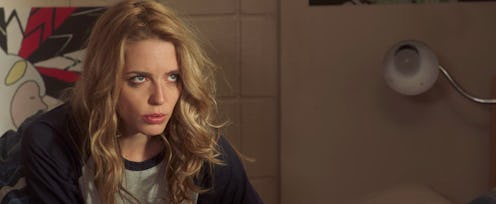Entertainment
The Sexist Reason You Won't Be Able To Predict 'Happy Death Day's Ending

Spoilers about the plot of Happy Death Day to follow. There is something almost every famous cinematic monster has in common. From Hannibal Lecter, Norman Bates, and Frankenstein's monster to Dracula, Freddy Krueger, and Jack Torrance from The Shining, nearly all of the most iconic horror villains are men. They are menacing and strong, violent and unpredictable. Their weapons are their unhealthy minds and a variety of sharp tools that cut into women's flesh. But in Happy Death Day, out now, the film's villain is, against all odds, a 20-something woman who uses a homemade cupcake to try to kill her victim.
The film follows Tree, a selfish sorority sister who wakes up on her birthday only to die by the end of the day. She relives this day over and over in a sort of Groundhog's Day from hell, and soon realizes the only way to break the cycle is to find out who is killing her.
Until the film's final moments, the identity of Tree's killer is a secret. The murderer, who is tall in stature with broad shoulders, wears black pants, a black long sleeve shirt, and a plastic baby mask. From the looks of the killer's attire alone, it's safe to assume the antagonist is a man. And the film is banking on this assumption for its big reveal: The true killer is Lori, Tree's roommate, who surprises her with a poisonous cupcake for her birthday, but in every version of the day she relives over and over, Tree refuses to eat the sweet treat.
As Tree runs through a list of all of her potential killers, we never once suspect Lori. Because she is a sorority sister, in nursing school (where she literally saves people's lives), and most notably, a woman, Lori never seems like a likely suspect. "I had no idea, I was completely shocked," says Jessica Rothe, who plays Tree. "It's one of the brilliant things about the film... finding out who the killer really is is so shocking."
Because where female victims in film (especially horror) are concerned, their killers are often misogynistic men. We are used to seeing men, especially in slasher films, commit violent acts against women, and this is what we assume is the case with Tree. Audiences are less used to seeing women behaving badly in film.
In 2013, Dan Wohl wrote about the lack of female villains for The Mary Sue, saying: "Having female characters in films shouldn’t be about getting in a few nice, positive moments for women and then calling it a day. It should be about naturally having an equal distribution of genders in film roles."
And this means having an equal number of female baddies. Because women can be as complex, powerful, and sure — evil — as men. This is why Happy Death Day's female antagonist is crucial.
However, her motives for attempted murder are not necessarily empowering to women. Because her reason for trying to kill Tree does, unfortunately, play into a typical trope — the jealous woman storyline: Lori is upset that Tree was having an affair with a man Lori was also interested in. Yet as Tree points out in their final confrontation, it is an extremely "stupid" reason to try to kill someone. Even in their final meeting, Tree not only confronts her killer, but she confronts this tired, sexist motive as well.
To toy with us further, the film offers up another likely suspect: a murderous man on the loose who only kills young, beautiful women. For of course, this is a classic horror trope, and Tree feeds into this victim stereotype in numerous ways. She is young, beautiful, and — a physical description Alfred Hitchcock once disgustingly referred to as "the best victims" because "they're like virgin snow that shows up the bloody footprints."
And while we expect Tree to play the victim, she refuses. "In the opening of the film you think she's the Drew Barrymore of Scream. You think she's like a pretty girl who falls victim, dies, and we don't see her anymore," Rothe says. But in reality, Tree is not the classic female casualty, but is instead, "pivotal to the story."
She is not a prop to propel the motives of our killer, but a flawed hero who is given the opportunity to make mistakes and learn from them. "We don't get to see female characters in horror learn from their mistakes very often. [Usually] they run up the stairs when they should run down. They run towards the noise. They run and scream, scantily clad."
But the film, thankfully, rejects these overused and harmful tropes. Tree runs and screams, yes, but she's being killed over and over again, and her (not-so-scantily clad) shrieks make sense. And as the film progresses, the film's protagonist "becomes her own saving grace — her own hero. She takes charge of her own fate and she exceeds all of our expectations... she turns all of the stereotypes on their head," as Rothe says.
So while Happy Death Day might seem like typical horror fare at first glance, a closer look will reveal a story about the kinds of women — an active hero and an unpredictable villain — we need to see in horror films.